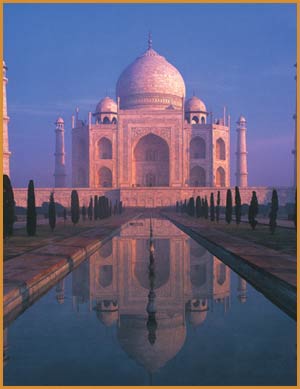
The Taj Mahal, erected by the Mogul Emperor Jihan Shah, is one of the most magnificent memorials in the world.
Some circles at the present time like to portray perverse and racist Hinduism as a religion of “peace and understanding”. They claim that Hindus are open-minded towards other religions and that they leave people in peace. This is a fraudulent claim. As we have stated in the previous chapter, Hinduism is a deeply racist culture, and the Hindu culture prescribes violence and oppression, not compassion, towards other religious denominations and even towards members of its own lower castes. The upper caste elite have been oppressing their own people for centuries as a requirement of the merciless caste system. However, the primary target of these often violent policies is what they describe as the “non-Hindu minorities,” like Muslims and Christians. The English historian Prof. Douglas Spitz, renowned for his research on Hindu nationalism, explains in his article titled “The RSS and Hindu Militancy in the 1980s” the illogical basis of Hindu nationalist ideology:
“According to RSS ideology, Hindu nationalism provides the antidote to false Nehruvian secularism. RSS thinkers maintain that Hindu (Bharatiya) culture is the only indigenous culture of India, and that India cannot be nationally integrated until all Indians share this culture, and recognize it as the foundation of their collective national identity. They assert that to achieve this goal of national integration based on a shared Bharatiya culture, two basic conditions must be met. First, Hindus must transcend their divisions of caste, sect, class, region and language, and realize that they form a mighty organic Hindu nation. Secondly, non-Hindus, particularly Muslims and Christians, whose religious and cultural inspiration originated in foreign lands, must adopt as theirs Hindu culture and its historical heroes.”92
The primary targets of these assimilation policies are the Muslims in India who form a large community of 200 million people.
Before the radical Hindu’s oppressive policies towards the Muslim people can be explored further, it is necessary to look at the deep-rooted history of Islam on Indian soil.
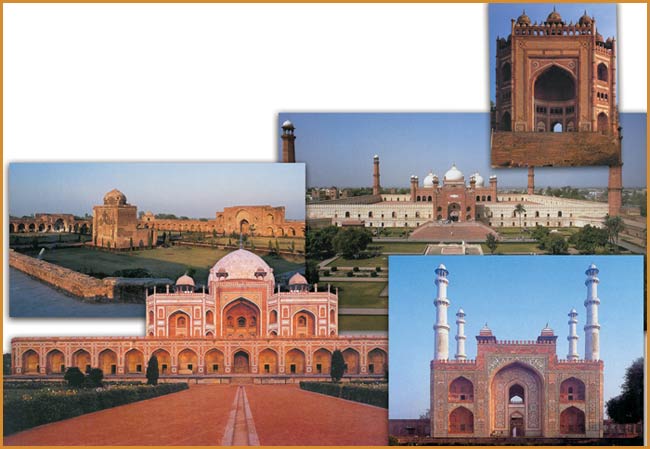
Palace of the Mogul Emperor Ekber Shah, 1569
Funerary memorial erected for the Mogul Emperor Humayun
The incomparable works of art from Muslim states within the borders of India are the best possible reflection of the superior nature of Islamic civilization
Badshah Mosque, Lahore, 1673-1674
The Buland Darwazaq, erected during the reign of Ekber Shah Buland Darwaza, Fatehpur, Sikri.
A work of art on the road leading to the tomb of Ekber Shah.
The Indian people became acquainted with Islam at the beginning of the 7th Century. With the Turkish invasion of India in the 11th and 12th Centuries, Islam spread rapidly across South Asia. The collapse of the Abbasi state saw the creation of many small Muslim states. Whilst these states continued their independent existences in Belucistan, Afghanistan, Multan and Sind, the first large Muslim state was created in 977 in Gazne. The state of Gazne united all the Muslim fiefdoms warring with one another under one name, much as the Ottoman empire was to do later in Anatolia. Subsequently, the Indian nation declared war on the Muslims. After a series of clashes, the Gazne state defeated the Indians in the Battle of Peshawar in 1008 and occupied most of North India. Uc, Gujarat, Lahor, Delhi and Bengal were conquered by Muslim forces. During the reign of Sultan Mahmud of Gazne, Islamic morality and culture spread rapidly across these idolatrous lands. The native population entered the Islamic faith in great waves, and by their own free choice. Sultan Mahmud, who made seventeen expeditions into India, drew the attention of the Islamic world with his relentless efforts to spread the Islamic faith. He was honored with the title of Sultan and his family with the title of Seref by the Abbasi Caliph. Sultan Mahmud’s reign of thirty years helped to establish Islam in India and in a sense, he was the founding father of the present-day Pakistan and Bangladesh.
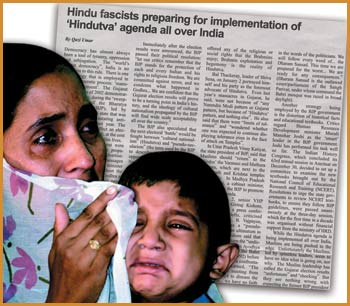
Fanatical Hindus reveal their hatred for Muslims and Islam by burning copies of the Qur’an during mass demonstrations.
Between 1206 and 1526, when the Indo-Turkish empire was founded, five different Muslim states ruled in India: The Memluk, The Haleci, The Tugluk, The Seyyid and The Ludis. In 1516, Timur brought the Ludi Empire to an end and his grandson, Babur Sah Mogul, founded his empire which governed the area until the 17th century. This empire weakened over time, contracted and ultimately collapsed. In 1858, the whole of the Indian subcontinent came under the colonial rule of the British Empire, and the area known as Indochina (today the nations of Vietnam and Cambodia), was colonized by the French.
In short, Islam has a deep rooted history in south Asia and the Muslims on the Indian subcontinent today are the descendants of the Emperors who ruled these lands for centuries. This is why it is possible to see the high Islamic culture and morality all across India where hundreds of millions of Muslims live. Countless mosques, madrassas, and many other historic buildings demonstrate Islamic civilizations great contribution to these lands.
The 200 million Muslims in India form the largest minority group in the world. However this large minority is face to face with ever escalating violence and oppression by radical Hindus. The Muslims of India are being martyred, their houses being burned down, being evicted from their lands and subjected to various means of torture and harassment by racist Hindu movements led by the Vishna Hindu Parishad Party (VHP). As the police generally side with the radical Hindus, most of those killed or injured are Muslims; yet despite this fact, the police typically apprehend the Muslims. One such situation occurred when on the 6th of December, 1992 the historic Babur mosque, built in the 16th century, was burned down.
Muslims living on Indian soil have been repeatedly exposed to barbaric attacks, especially since the rise of radical Hindu nationalism over the past fifty years. One of the worst such attacks was the destruction of the Babur mosque in Ayodhya.
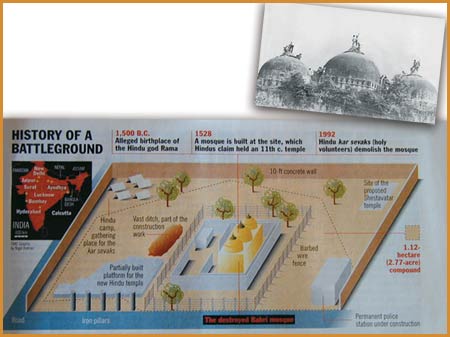
A report in the 21 December, 1992, edition of Time magazine discussed the history of the debate over the Babur Mosque. There was no conflict between Muslims and Hindus between the construction of the mosque in 1528 until 1855, when the claim in question was made. In 1934, Hindu fanatics tore down part of the mosque walls. As the debate continued, in 1983 the World Hindu Association initiated a campaign to have the mosque pulled down and a new place of worship erected on the site. Clashes increased rapidly after that date. In 1992, the mosque was totally destroyed by Hindu fanatics.
This mosque was commissioned by the Mogul emperor Babur Sah 430 years ago, and is of great importance for Indian Muslims. This mosque was the cause of dispute for ages between Hindus and Muslims. Hindus claim that this historic building, a monument of Islamic civilization, was built on the birth place of Rama, one of their so-called deities, and therefore wanted to see it torn down in order to build a Hindu temple in its place. The only basis of this claim is hearsay based on fairytale like legends. They themselves invented this nonsensical belief, and acted for centuries on it.
One of the foremost names on Indian history and Hinduism, Professor Brian K. Smith of the University of California, reveals some shocking facts about Ayodhya and the Rama temple in his work entitled “Re-envisioning Hinduism and evaluating the Hindutva Movement” .93 One of the pieces of evidence put forward by Professor Smith is a research paper by The Archeological Survey of India. The chairman of this organization, Prof. B. B. Lal, reported that following extensive research, no evidence could be found in support of the claim that there was ever a Hindu temple in the past in the Ayodhya area. Another source Smith relies on, is a research project by the University of Jawaharlal Nehru, one of India’s most respectable universities. The university’s historical research department publishes a periodical under the title “The political Abuse of History”. It reveals a great lie in the case of Ayodhya. The claim that there was a temple in the past in Ayodhya is a blatant falsehood as there is absolutely “no evidence”, and never was for the existence of such a temple. Hindu radicals however, disregard this fact and continue to claim that besides Ayodhya, there are 3,000 sacred sites across India which were conquered by Muslim emperors. Many people express their concerns about these sites as they too could become other Ayodhyas in the near future. According to Indian researchers, one of the next targets of Hindus could be a 17th century mosque in Benares.94
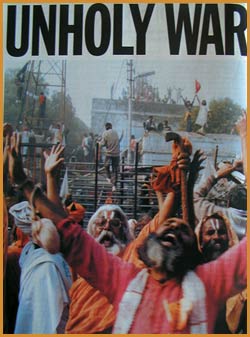
A report in Time magazine titled “Unholy War” covered demonstrations of joy by fanatical Hindus in the wake of the tearing down of the Babur Mosque.
Time, 21 December 1992
The first big campaign seeking the demolition of the Babur mosque was kicked off by the BJP in the autumn of 1990. The then leader of the party, L. K. Advani, toured the region in his vehicle, intentionally inciting people to begin an uprising with the intent of demolishing the mosque so a temple could be built in its place. A minibus was decorated to resemble the chariot of Mahabharata, a Hindu deity, for this purpose and toured 20 big cities and hundreds of towns and villages. This program started the ceaseless attacks on Muslims. The raging mob climbed over the walls of the mosque and onto its 16th century roof where they erected Hindu flags. No inquiry was ever held into this affair. This act of provocation netted the BJP an explosive increase in the votes it received.
Attacks targeting the mosque increased further in 1992. 50,000 Hindus gathered in front of the Babur mosque for a great showdown following the Advani’s campaign on Friday the 4th, 1992. The next day, they launched further attacks in large groups and ultimately destroyed the 430 year old Babur Mosque. This attack resulted in violent clashes between Muslims and Hindus. This was an offensive planned and encouraged for years by Sangh Parivar’s member parties like the VHP. In the buildup to this attack, Ram Chandra Pramhans, one of the leaders of the VHP, which supported the idea of building a Rama temple on the site of the Babur mosque, made provocative statements.
In the ensuing clashes more than 2,000 Muslims were martyred. The foremost supporters of these events were the ruling government party, the BJP, and its Prime Minister Vajpayee. It had close ties to racist organizations like the VHP. The conflict spilled over to other countries like Pakistan, Bangladesh and Britain where more clashes took place and the already tense situation between Pakistan and India worsened.
The Indian government promised to rebuild the destroyed mosque in 1992 in order to diffuse the situation but ten years later, no steps have been taken in that direction. Worse yet, the government remained silent when plans emerged to build a Hindu temple on the site. In 2003, radical Hindus, taking heart from the government’s stance in this matter, moved to begin the construction of this temple. Quite understandably, Muslims would not let them, and in the subsequent clashes a further 700 people died.
One of the most respected human rights organizations, Human Rights Watch, revealed detailed information about this attack on Muslims and other similar cases in India. One of the HRW reports, published in 1994, stated that the attack on the Babur mosque in Ayodhya took place as a consequence of the BJP government and other radical Hindu nationalist groups’ campaign, and that neither the police nor the other security forces intervened to stop the massacre. The following information is from this report:
“Despite promises by BJP state government officials that the mosque would be protected, police at the site reportedly refused to intervene to prevent either the demolition, or subsequent attacks on journalists and others. More than 1,000 died in the violence that followed in cities across northern India. A disproportionate number of those killed were Muslims shot by police. In some cases, those shot dead were pulled from their homes and summarily executed. In Surat, in the state of Gujarat, attacks on Muslims included the gang-rapes of women. In January, Muslims in Bombay were again the principal target during nine days of violence in which more than 700 people were killed. The Bombay police, many of whom reportedly support the Hindu militant Shiv Sena organization, deliberately targeted Muslims or stood back while mobs burned Muslims’ homes.”95
From time to time the tensions calm, but the conflict goes on. Repeated attempts at building the Hindu temple on the mosque’s site play a major role in keeping the conflict alive, alongside the governments backing for the Hindu cause. Consequently, Hindu militants torch Muslim houses and assault Muslim women and many innocent people inevitably lose their lives.
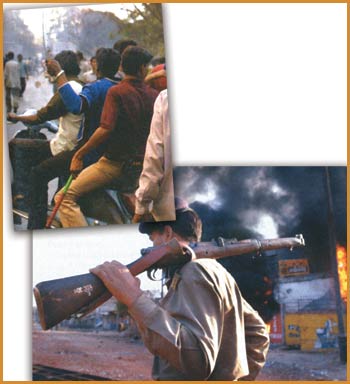
Homes were looted in Gujarat, and people burned alive or beaten to death. Mayor Modi and the security forces turned a blind eye as this was going on.
Attacks like the one on the Babur mosque have become almost common practice in India over the years. Every conflict leads up to the torching of Muslim’s houses, workplaces and cars. In many cases Muslims have perished in the flames when their homes were set alight as they slept.96 The government appears to take preventive action, but in reality, certain radical groups (that are in fact sometimes in the administration) give silent yet decisive support to such attacks. This is a fact established by human rights organizations. For instance, Human Rights Watch has prepared a number of reports on Muslims’ persecution in India, revealing the conduct of government officials, local governments, and the security forces based on eyewitness accounts.97 Radical Hindus, encouraged by Hinduism’s racist philosophy continue to carry out such attacks.
The behind the scenes politics that led to the destruction of the Babur Mosque and the tensions thus created, are the same as in the events that began with an arson attack on a train in mid -2002 and culminated in the martyrdom of 2,000 Muslims. A train carrying a group of radical Hindus was torched. It was claimed that Muslims were responsible for this attack, but soon enough, voices were heard suggesting that a provocative conspiracy was at work. A report filed by the BBC appeared to confirm this version of events; some people on the train claimed that a group of Muslims stopped the train, and then started the fire, but autopsy as well as eyewitness reports contradicted this scenario and proved that the fire was started from within the train.98 After this arson attack on the train, the government was quick in pointing the finger of blame at Muslims, thereby provoking Hindu militants into action. Racist organization like the RSS had found the perfect opportunity they were looking for. Encouraged by the conduct of certain people inside the Indian government, Hindu aggressors launched their vicious attack on the Muslims. Mobs composed of hundreds of militants raided Muslim households, torched and looted homes, raped women, burned people alive, looted shops and ran people over with lorries; the massacre continued for days. Corpses were thrown into canals and rivers and the police force took no action whatsoever to end the violence, nor did the local administration or government. To the contrary, many cases of rape and arson took place with police assistance, or under police protection.

Newsweek, 22 April 2002
Newsweek, 22 January 1999
(above) A report in Newsweek magazine opening with the words “Less than half of Muslim children attend school and literacy rates are lagging” described the physical and psychological pressure placed on the Muslim population, which exceeds 200 million, by Hindu nationalists. The report covered a demonstration by Gujarat Muslims against the biased attitude of the police in the face of attacks by Hindus. The same report also stated that Hindus had attacked Christian churches and schools. (Side) A report titled “A Free Reign of Terror” described how the Christian minorities in India frequently hold protest marches to complain about attacks.
One of the worst massacres took place in Ahmedabad, a city in western India. Again, the police and military forces failed to take action to prevent or end the violence. Journalists reported that gangs wreaked havoc across the city, torching cars and looting shops and setting fire to them with the police simply standing by and watching. Then the radical Hindu mob turned their attentions to the Narora shantytown where they burned 27 Muslims alive, mostly children. Hindu gangs patrolled the streets, stopping cars at random asking the occupants “whether or not they were Muslims”. Hindus were allowed to drive on, whilst Muslims were taken out of their cars and martyred.99 A storeroom in which eleven Muslims were hiding was set ablaze, martyring seven of them. A family of eight were burned to death in their car. In an attack in which knives, metal bars, swords, and baseball bats were used resulted in the deaths of forty eight people. Hospitals were overflowing with casualties, most of whom bore knife wounds. In many towns, slogans like “learn from us how to burn Muslims” were painted on walls and Hindu militants, when being interviewed by foreign journalists, said things like: “whatever is happening here it is good because the only way of solving this problem is by exterminating the Muslims”.
The events of Gujarat made news across the world and human rights organization filed many reports, but neither the news nor these reports could persuade the Indian government or, for that matter, the global community, to take any action. A report entitled, “The Gujarat Massacre Affected Minority Women, The Survivors Speak” based on first-hand accounts of women who survived these attacks revealed the following:
-The violence did not escalate into a massacre by itself. It has been established that there was preparation, organization and pre-planned targeting.
-Among the women in the survivors camps, there are women who had been raped, gang raped, mass raped, paraded naked, violated with a variety of objects, assaulted and subjected to the most repulsive acts of sexual violation. Many of the raped women were subsequently burned alive.
-The effect on these women is psychological, physical and financial. There is no evidence whatsoever to suggest that the state helped them in any of these three areas.
-Certain media organizations, broadcasting in the native language of Gujarat, played a dangerous and frankly criminal role in inciting the public to partake in the massacre and encouraging them to participate in the sexual violation of women.

Milli Gazete, 3 March 2002
Hindus burn people alive
-Pregnant women had their bellies cut open and their unborn children cast into fires.
-No newspaper or TV station reported on rape or any other assaults on women, and the police and government completely ignored these attacks.
-Many children witnessed these barbaric crimes of rape and arson, causing trauma and severe psychological damage to them.
-The state did not display any signs of remorse for failing to do its job. Government officials sufficed with saying: “There was nothing that could have been done. All Hindu hearts were filled with a natural hate and rage and we could not have controlled these emotions.”
-There is significant evidence suggesting that the police aided the mob, cooperated with them or, even worse, directed them in some cases. There is video footage showing slogans being painted on the walls of Muslim’s houses reading, “the police are on our side, too”. In other cases, the police just ignored calls for help or retorted, “We have not had orders from above to help you”. Women and children were turned away by police patrols or at the police station by policemen saying: “Help yourselves”. Many calls for justice were rejected on the grounds that there was insufficient evidence to file a report, and that therefore there was no case.100
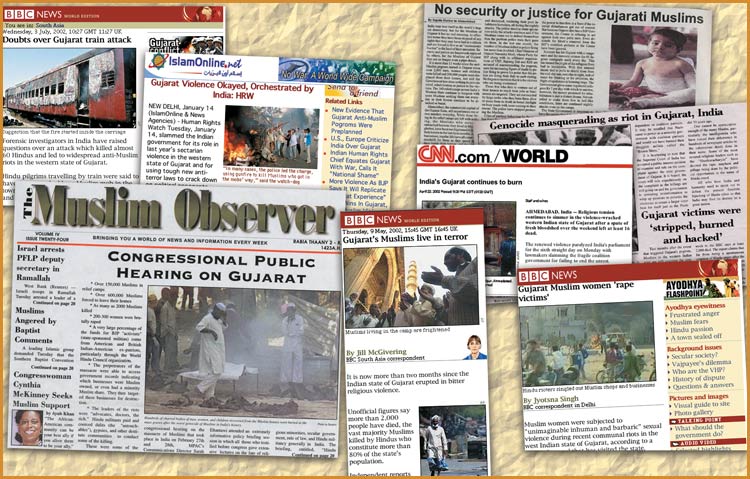
BBC, 3 July 2002
IslamOnline.net, 11 January 2003
The Muslim Observer, 14 June 2002
Public Hearing into Gujurat in Congress
BBC, 9 May 2002
Gujurat Muslims are living in fear
BBC, 16 April 2002
The Muslim Observer, 31 May 2002
There Is No Security Or Justice for Muslims in Gujurat
The Muslim Observer, 3 May 2002
Genocide under a Mask of Rebellion in Gujurat
CNN, 22 April 2002
Indian Satet of Gujurat Continues to Burn
The acts of violence that had been going on in Gujurat for weeks made their way into the world press. However, the Hindu nationalist dominated government acted very slowly in putting an end to the assaults. They waited for days, turning a blind eye to people being killed and burned alive. Statements issued referred to the attacks as “normal.” (side, top) A BBC report under the headline “Doubts over Gujurat train attack” dated 3 July, 2002, covered concerns that the train act that had triggered off the events in Gujurat had been a deliberate act of provocation. The world press described how Muslims were living in fear, women were being raped and everywhere was filled with charred corpses. Another report on the BBC, dated 16 April, 2002, was titled “Gujurat Muslim women rape victims” Another noteworthy feature of the report was the way that the security forces had made no move to put an end to the attacks. The Islamonline web site carried a report by the Human Rights Watch Organisation headed “Gujurat Violence Okayed, Orchestrated by India: HRW” A CNN report was headed “India’s Gujurat continues to burn.”
Before we examine the violent practices Muslims are subjected to by certain radical circles within the Indian administration, it is necessary to familiarize ourselves with an overview of the Kashmiri people’s experiences.
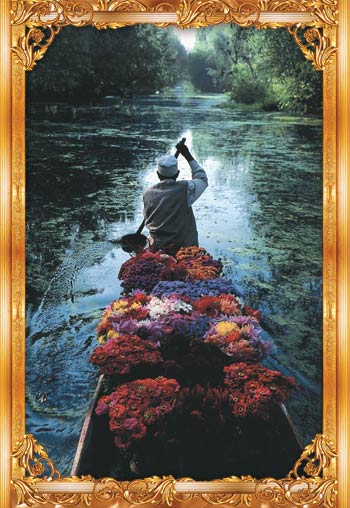
Say: “Praise be to Allah and peace be upon His servants whom He has chosen.” Is Allah better, or what you associate with Him? (Surat an-Naml: 59)
Kashmir has one of the world’s richest ruby, emerald and gold reserves. The area has been under Indian occupation since 1947. As it is a mountainous region on high grounds, it is a strategic area that is easily controlled. The Kashmiri population seeks either to become an independent Muslim nation or wishes to merge with Pakistan. For decades they have been forced to live with an economic embargo, violence, unjustified arrests, torture and bombings.

For decades the people of Kashmir have faced economic embargoes, acts of violence, unjustified arrests, torture and bombings.
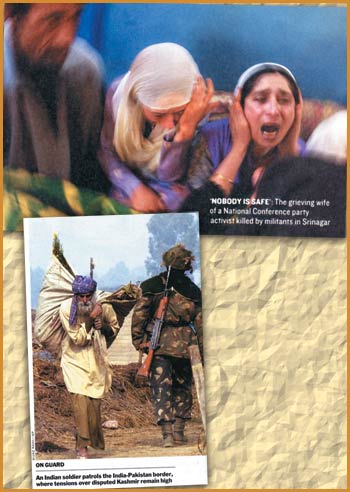
Newsweek, 30 September 2002
Time, 4 February 2002
Tens of thousands of Kashmiris were martyred in three terrible massacres perpetrated by Indian forces in 1947, 1965 and 1971. Even today, Kashmiris spend every moment of their lives under the control of Hindu security forces. The above report in Newsweek shows a Muslim woman whose husband was killed by Hindu militants.
The Indian subcontinent was under British colonial administration until after the end of the Second World War. When the colonial powers withdrew from the area, Indian Muslims sought their own independent country and founded Pakistan in 1947. Pakistan and India agreed on a population exchange and many Muslims subsequently migrated from India to Pakistan. However, India managed to keep the predominantly Muslim district of Jammu-Kashmir within its control by means of various political intrigues and the support of the British and ever since, the Kashmiri people live under the oppression of radical Hindus.
To begin with, India opposed the formation of an independent Muslim state, which is why they were frustrated by the founding of the Pakistani nation. Kashmir became the central issue between the two governments. Two wars were fought over the issue of Kashmir, but the problem remains unresolved. At present, one part of Kashmir is under Pakistani administration (called Free Kashmir), but most of it remains under Indian occupation. The UN passed a resolution to let the Kashmiri people decide between India and Pakistan in a referendum, but the Indian government has thus far refused to comply. Understandably, Kashmiri freedom fighters have their organizational bases in Pakistan, which is why India is so hostile towards this country. India is lobbying international organizations to pressure Pakistan in this regard. India poses a great threat to Pakistan’s security with its nuclear capability. Pakistan, a nuclear power herself, is constantly pressured by the international community, which turns a blind eye when it comes to India’s nuclear arsenal.
The part of Kashmir under Indian occupation covers an area of 138,935 km2 (53,64 square miles), and has a population of around nine to ten million, of which 80% is Muslim. The remainder is made up by Hindus, relocated there afterwards. The Indian government has half a million troops in the region and along the Pakistani border in order to maintain the status quo there. The army has been given a free hand to suppress the freedom fighters and to oppress the Muslim population. Some predominately Hindu soldiers have been trained to hate Muslims, and they abuse their powers to the fullest with brutal killings, merciless torture and rape. The hospitals and health institutions in Kashmir are full and often overflowing with those injured by attacks carried out by some Hindu troops. According to a joint report by the human rights organizations Asia Watch and Physicians for Human Rights, the rape policy of the Indian administration towards Muslim women works as follows:
«As the conflict in Kashmir enters its fourth year, central and state authorities have done little to stop the widespread practice of rape by Indian security forces in Kashmir. Indeed, when confronted with the evidence of rape, time and again the authorities have attempted to impugn the integrity of the witnesses, discredit the testimony of physicians or simply deny the charges everything except order a full inquiry and prosecute those responsible for rape. …
Since January 1990, rape by Indian occupation forces has become more frequent. Rape most often occurs during crackdowns, cordon and search operations during which men are held for identification in parks or schoolyards while security forces search their homes. In raping them, the security forces are attempting to punish and humiliate the entire community. …
The security forces have entered hospitals, beaten patients, hit doctors, entered operating theaters, smashed instruments. Ambulances have been attacked, curfew passes are confiscated. …
The most common torture methods are severe beatings, sometimes while the victim is hung upside down, and electric shocks.”101
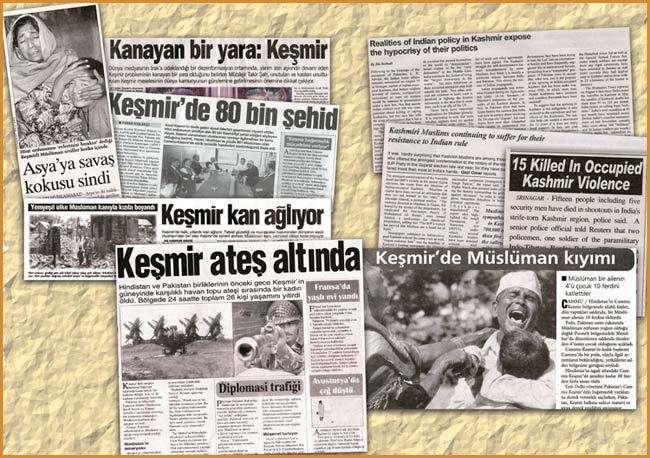
Yeni Asya, 1 February 2003
A bleeding wound: Kashmir
Yeni Şafak, 23 September 2002
80 thousand martyr in Kashmir
Radikal, 26 December 2001
An air of war has settled in Asia.
Akit, 22 September 2000
Kashmir is bleeding
Yeni Mesaj, 4 January 2000
Kashmir is under fire
Milli Gazete, 22 January 2002
Muslim massacre in Kashmir
Two separate reports in Crescent magazine, one titled “Realities of Indian policy in Kashmir expose the hypocrisy of their politics” and the other “Kashmiri Muslims continuing to suffer for their resistance to Indian rule” detailed the suffering inflicted on the people of Kashmir by the Indian government. Weekly Mirror International carried a report under the headline “15 killed in occupied Kashmir.” Tens of thousands of innocent people have lost their lives in attacks on Muslims in Kashmir, and rape has become a systematic policy of the Indian police. For around half a century the people of Kashmir have not spent one single day in peace and security. Yet all they want is to be able to live freely according to their faith, raise their children in security, and to sleep safely in their beds at night.
The Kashmiri Muslims have resisted the Indian administration and fought to gain their independence since 1947. The Indian forces have committed large scale genocide on three occasions; in 1947, 1965 and 1971 in order to break the resistance. Tens of thousands of Kashmiri Muslims have been martyred, and more than 4,000 women have been raped or otherwise tortured. Schools providing religious education have been closed.102 The worst ever assimilation and persecution campaign began in 1990. People have been wrongfully apprehended and tortured to death. Houses have been torched, defenseless people have been violently oppressed, and schools and newspapers have been shut down. A report by the British newspaper The Independent describes the systematic torture implemented in Kashmir as follows:
“Young girls were not being raped systematically by entire (Indian) army units rather than by a single soldier as before. Girls are taken to soldier’s camps and held naked in their tents for days on end. Many never return home. ..Women are strung up naked from trees and their breasts lacerated with knives, as the (Indian) soldiers tell them that their breasts will never give milk again to a newborn militant. Women are raped in front of their husbands and children, or paraded naked through villages and beaten on the breasts.”103
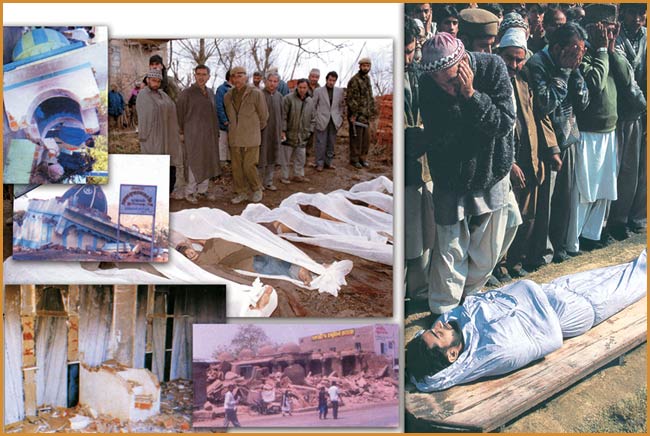
The policy of systematic assimilation and genocide aimed at the Muslims of Kashmir by Hindu forces is taking place before the eyes of the world. Every day, more young people are martyred, women are raped, mosques torn down…
Nor have they been content with perpetrating armed assaults or torture against Muslims. Dams built for farm irrigation have been used to harm Muslims too. They let the dams fill with water and then open the release gates during the monsoon rains and thereby flood lower Kashmir (or free Kashmir), and parts of Pakistan further downstream, causing the death of thousands of people and great environmental damage. The following article by The Toronto Star sums up the suffering the Kashmiri people have had to endure:
“Subjugated, humiliated, tortured and killed by the 650,000-strong Indian army, the people of Kashmir have been living through sheer Hell for more than a year, the result of an increasingly brutal campaign of state repression. India hides behind its carefully-crafted image of “non-violence” and presents itself in international forums as a model of democracy and pluralism. Yet, it is unable to stand up to the scrutiny of even its admirers. All journalists, especially television crews, were expelled from the Valley. With no intrusive cameras to record the brutalities of the Indian forces, the world has been kept largely in the dark…”104
In October 1993, a massive attack was launched against the Hazratbal Mosque in the Kashmiri capital Sirinagar. The Hazratbal Mosque, claimed to be the military command center of Muslim forces by the Indian authorities, was besieged for an entire month. During the siege more than 100 people were killed and 300 innocent people were arrested. The town’s electricity and water supplies were cut off during the siege.
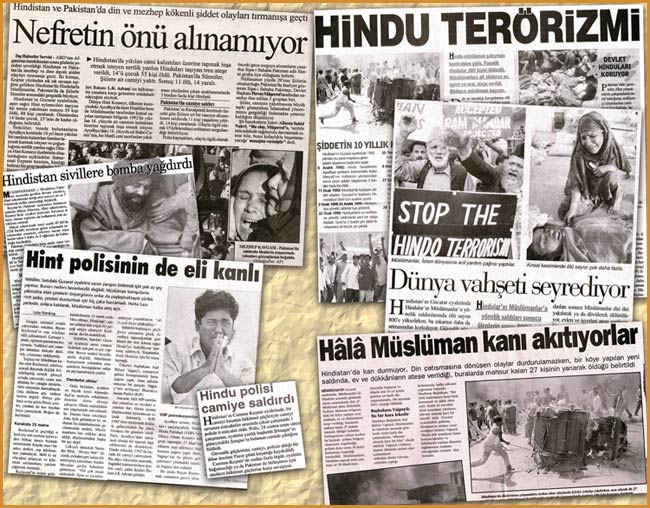
Cumhuriyet, 28 February 2002
Rage can not be overcome
Milli Gazete, 29 January 2002
India poured bombs over the civilians
Evrensel, 5 March 2002
The Indian police’s hand is also bloody
Yeni Mesaj, 13 June 2001
The Indian police attacked a mosque
Yeni Şafak, 2 March 2002
Hindu terrorism
Yeni Şafak, 5 March 2002
The world is watching the atrocity
Ortadoğu, 3 March 2002
They are still pouring the blood of Muslims
Besides the state terror by the Indian administration in Kashmir, there is also a serious refugee problem. Sefer Turan, a reporter for the Turkish TV station Channel 7, visited the refugee camps in Kashmir and the following are some of his impressions from the situation he encountered there:
The Ambor refugee camp was created in 1990 to house the Kashmiri people fleeing from Jammu Kashmir. Living standards here are way below normal. People are crammed into tiny mud huts. We entered a single room hut where we found one bed. When we asked how many people lived here we were told: “nine”. There are 214 families, or 1,110 people living in this camp. To see that the living standards here are extremely poor, it is sufficient to enter just one hut. Most huts have two rooms and a few useless pots and pans, one or two beds, but you would need a thousand witnesses to make believe that these are actually beds. In the corner sits a mother with her baby in her arms. We see a small fire with a little pot on it. There is no sign anywhere of dry or fresh food, and I was too embarrassed to see what is boiling in the pots. In none of the tents we entered did I see food or (proper) beds. In one of the tents we saw a small piece of white worn fabric on the floor. This must have been a bed! I asked how many people lived in this tent and I was told eleven people. Outside there was the odd tin pot boiling on a little fire.105
The way this policy of oppression has been able to persist so easily for over fifty years in Kashmir is to do with the support it receives from certain anti-Islamic, materialist and Darwinist circles in the West. The Kashmiri Muslims have been pressured to surrender to radical Hindus by the UN’s unenforceable resolutions. On the whole, the great majority of the world’s media simply ignores the tyranny in Kashmir, but when they choose to remember Kashmir, the situation is usually presented in a biased fashion with comments like: “An uprising in an Indian district has been suppressed”. For instance, The New York Times published an article on the 22nd of January, 1990 in which Pakistan was accused of supporting Muslim rebel groups in India, thereby “destabilizing the country”. Pakistan protested.106 Certain western media groups frequently publish such biased views.
In recent years, the oppression and assimilation campaign aimed against the Muslim population of Kashmir has intensified. Fanatical Hindu movements seeking to exterminate the Muslim population in Kashmir, as well as in the rest of India, has been demonstrated by their involvement in the destruction of the Babur Mosque, and as the Ahmedabad massacre in Gujarat proved. The tyranny to which the Kashmiri Muslims are exposed to is indescribable. However, as always, what is happening in Kashmir and around the region is portrayed through various propaganda tactics in an altogether different light for public consumption. The tyranny, torture and oppression of people are concealed, and the whole world remains silent about it. The world acts as if the reports by human rights organizations simply do not exist. The only thing the Kashmiri people, terrorized for over fifty years by India, wish for, is to be able to live in a secure environment in which they can practice their faith without obstruction, where they are not violated because of their faith, and where they can raise their children in peace and security.
92 Douglas Spitz, "The RSS And Hindu Militancy In The 1980's", Http://Department.Monm.Edu/Classics/Speel_Festschrift/Spitz.Htm., Monmouth College
93 Brian K. Smith, "Re-Envisioning Hinduism And Evaluating The Hindutva Movement", The Academic Press Limited, 1996.
94 "The Political Abuse Of History: Babri Masjid – Rama Janmabhumi Dispute", Centre For Historical Studies. "Re-Envisioning Hinduism And Evaluating The Hindutva Movement", Brian K. Smith, The Academic Press Limited, 1996
95 "India: Human Rights Developments", Human Rights Watch, Http://Www.Hrw.Org/Reports/1994/WR94/Asia-05.Htm#P235_88637
96 "Hindu Terörizmi", (Hindu Terrorism), Http://Www.Geocities.Com/Muslim_Tr/Hindu_Terorizmi.Htm
97 Human Rights Watch. For The Reports See:Http://Www.Hrw.Org/Reports/World/India-Pubs.Php
98 "Doubts Over Gujarat Train Attack", BBC News, 3 July 2002,Http://News.Bbc.Co.Uk/2/Hi/World/South_Asia/2087709.Stm
99 "Massacre Under Police Surveillance", Evrensel, 2 Marc 2002
100 "How Has The Gujarat Massacre Affected Minority Women - The Survivors Speak",Citizen's Initiative,Http://Www.Mnet.Fr/Aiindex/Women_S_Reportgujrat02.Html
101 Asia Watch And Physicians For Human Rights, May 09, 1993, Cited In “Examples Of Indian Atrocities In Kashmir”, Http://Hellinparadise.150m.Com/Examples.Htm
102 Hilal Ed-Dawli, May 1992 (Harun Yahya, Yeni Masonik Düzen, Vural Yayıncılık, Şubat 1996, P. 615)
103 The Independent, 18 September 1990
104 The Toronto Star, 25 January 1991
105 "Keşmir", Sefer Turan, Kanal 7